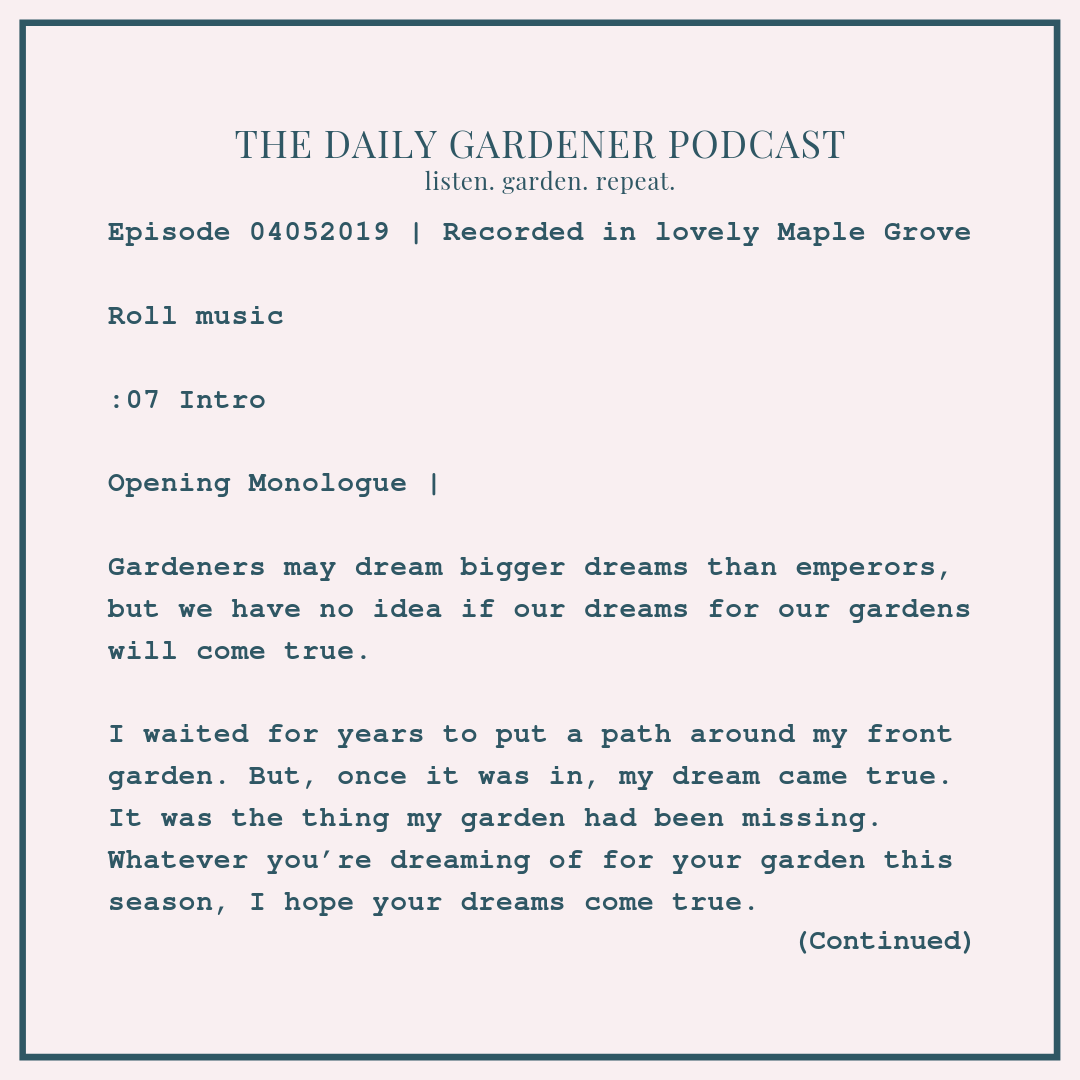September 9, 2019 The Miracle Tomato, Flowers of the Forest, Georg Ehret, James Arnold, Beverley Nichols, The Proven Winners Garden Book by Ruth Rogers Clausen and Thomas Christopher, Plants for Next Year, and Red Carnation Day
I thought I'd start today's show off with a quote by Beverley Nichols from his book, Sunlight on the Lawn:
“Why do insurance companies, when they want to describe an act of God, invariably pick on something which sounds much more like an act of the Devil? One would think that God was exclusively concerned in making hurricanes, smallpox, thunderbolts, and dry rot. They seem to forget that He also manufactures rainbows, apple-blossom, and Siamese kittens. However, that is, perhaps, a diversion.”
This quote by Nichols came to mind when I heard the wondrous story about the little tomato plant that had sprouted on a piling by the Brooklyn Bridge. It made Nightly News after the story was first published by the New York Times on Wednesday, along with a photo taken by a passerby, Matthew Frey.
Paddle-boarding between Pier 1 and 2 in Brooklyn Bridge Park, Frey saw the leaves first. His incredible image of a lone tomato plant growing straight up with no supports and with one perfectly red little tomato was heartwarming. It reminded me of the Charlie Brown Christmas Tree but with only one red ornament hanging proudly in the middle of the plant. Frey, who is 54, told the times:
“I’m used to seeing things grow here, but nothing as special as that... Things like that just make me happy.”
Beverley Nichols would have loved seeing the little tomato plant that could. To him, it would have been heaven sent - a small gift to us all from above.
Brevities
#OTD On this day in 1513, James IV of Scotland, along with other Flowers of the Forest, was killed in the battle of Flodden.
The Scottish army, led by James, was taking advantage of Henry VIII's absence in France, but they were resoundingly crushed by a militia organized by Katherine of Aragon, Henry VIII's 1st wife.
It was the most massive battle ever fought between England & Scotland, and it was a devastating defeat for the Scots who remembered the pain of an estimated 12,000 dead sons of Scotland in an old Scottish folksong called “The Flowers of the Forest.”
There are many variations of the lyrics that have surfaced over the years.
One of the oldest verses ends this way:
"' The Flowers of the Forest that fought at the foremost,
The prime of the land is cold in the clay'"
In 1765, the socialite Alison Cockburn wrote her own lyrics to the Flowers of the Forest. Here's the first verse:
I've seen the smiling
Of fortune beguiling,
I've tasted her pleasures
And felt her decay;
Sweet is her blessing,
And kind her caressing,
But now they are fled
And fled far away.
#OTD Today is the anniversary of the death of the botanist and the incomparable botanical illustrator Georg Dionysius Ehret who died on this day in 1770.
Ehret was born in Heidelberg, Germany, to Ferdinand Christian Ehret, who was a gardener and also had a talent for drawing. He taught his son both skills- gardening and drawing - before he died.
Ehret made his way to Regensburg. There, he met an apothecary who hired him to draw of specimens from his herbarium and garden. Ehret earnestly took on the job, attracting over 500 pieces in one year. Taking advantage of his young employee, the apothecary fired Ehret and told him he should have completed 1,000 drawings and was fired. It was basically his way of avoiding paying Ehret.
After this dreadful experience, Ehret made his way to England and worked at the significant botanical gardens - Including Chelsea Physic.
Isaac Rand, the first director of the Chelsea Physic Garden in London, told Ehret to paint the rare plants in the garden. The uniqueness of the specimens added to the demand for Ehret's work. As a result, Ehret was on friendly terms with the plant collectors and naturalists of his time. Chelsea was formative professionally and personally for Ehret; He married the head gardener's sister-in-law, Susanna Kennet.
In The Art of Botanical Illustration, Wilfrid Blunt noted that,
“By the middle of the century he had become a popular figure in London society: the highest nobility in England clamored to receive instruction from him,”
Indeed, the wealthiest woman in England, Margaret Cavendish Bentinck (the Duchess of Portland), gladly retained Ehret as a drawing instructor. Struck by the luminescence of his work, and ultimately she would buy over 300 of his paintings.
In 1737, Ehret was hired to draw by Sir Charles Wager, First Lord of the Admiralty. In August of that year, Wagner's personal garden is where Ehret first observed the Magnolia grandiflora flowering. The bloom was so inspiring that Ehret walked for an hour each way, from Chelsea to Wagner's house (in Fulham), to see and sketch every stage of the Magnolia grandiflora; from bud to full flower. Ehret's work provided the world with the first Magnolia to be illustrated in England.
Beyond his work in England, Ehret traveled throughout Europe in pursuit of his craft. He met Linnaeus in Holland when he was visiting the botanical garden in Leiden.
Linnaeus taught Ehret exactly how he wanted plants to be dissected and drawn. By this time, Ehret felt that his drawings were already aligned with Linnaeus, but the calibration didn't hurt; Ehret's work made it possible for Linnaeus to show the differences between plants for his books. When Linnaeus released his catalog of rare plants, "Hortus Cliffortianus," in 1737, it featured 20 meticulous plates made by Ehret.
As a result of partnering with Linnaeus, Ehret understood plant structure on a level that rivaled most botanists. Ehret's style of drawing is referred to as the Linnaean style.
Ehret's father could have never predicted the impact of teaching his son both gardening and drawing, but the two skills had come together in Ehret in an extraordinary way. One expert wrote that,
"[Ehret] was the greatest artist illustrator that Linnaeus had."
Today, Ehret's work is difficult to source. Given the rarity of an Ehret drawing, they are expensive to acquire; pieces generally start around $1k (if you can find one.)
Just this year, the NYBG organized an exhibit called "Georg Ehret: The Greatest Botanical Artist of the 1700s.” They featured 48 Ehret watercolors and engravings.
#OTD Today is the birthday of James Arnold, who was born on this day in 1781 and who was the namesake for Harvard's Arnold Arboretum.
The Arnold Arboretum was the very first arboretum in the United States.
Arnold was born to a Quaker family in Providence, Rhode, Island. In 1807, Arnold married Sarah Rotch. Had Arnold not married Sarah, there would have probably never been an Arnold Arboretum. Sarah's father was part of a wealthy whaling family. Through his marriage to Sarah, Arnold eventually became a partner in his father-in-law's business.
Arnold used his wealth to buy an 11-acre estate. There he built a mansion and installed beautiful gardens and lawns. The property was so stunning that the Arnolds opened their gardens to the public on Sundays. It was a rare opportunity.
The Unitarian minister, William Potter, called the Arnold estate,
"a home the most conspicuous among all our homes for culture, for hospitality, for charity."
John Quincy Adams was a guest of the Arnolds in 1835 and 1843.
When Arnold died in 1868, he had outlived both his wife and daughter. As part of his will, he left $100,000 in the hands of three trustees: Francis Parker, John James Dixwell, and George Emerson. Emerson and Dixwell were essential to the founding of the Arboretum because they personally knew Asa Gray at Harvard, and they also knew that Harvard wanted a Botanic Garden. When the arrangements for the arboretum were finally settled, the instructions were to collect every kind of tree and shrub that would grow outdoors in Massachusetts.
In 1873, Charles Sprague Sargent was hired to be the Arnold Arboretum director - a position he would hold for over four decades. His vision, combined with the stability provided by his great leadership established a solid foundation for the Arnold Arboretum. With the gift from James Arnold, the Arboretum had the means; and with the direction of Sargent, it had the expertise. Both were needed to create the world-class arboretum we enjoy today.
Unearthed Words
This week I'm going to do a special tribute to the author Beverley Nichols, who was born on this day in 1898.
Nichols is remembered for his writing and his love of gardening and cats. Nichols wrote over 60 books - but he is best remembered for his gardening books.
In 1932, Nichols wrote Down the Garden Path. It became an instant bestseller on both sides of the Atlantic. In the book, Nichols wrote about his 1928 purchase of a weekend retreat, a thatched cottage in the village of Glatton. Nichols knew nothing about gardening when he bought the cottage, so he shared every discovery and disaster in his books. Based on the positive response to his first book, Nichols wrote two more books on his Glatton experiences. The second book was “A Thatched Roof” (released in 1933), and the third was “A Village in a Valley” (released in 1934). The books are referred to as “The Glatton Trilogy” or “The Allways Chronicles.”
Here are some excerpts from Nichol's first book, Down the Garden Path:
“...a cyclamen that looks like a flight of butterflies, frozen for a single, exquisite moment in the white heart of Time...”
“It was not till I experimented with seeds plucked straight from a growing plant that I had my first success...the first thrill of creation...the first taste of blood. This, surely, must be akin to the pride of paternity...indeed, many soured bachelors would wager that it must be almost as wonderful to see the first tiny crinkled leaves of one's first plant as to see the tiny crinkled face of one's first child.”
“I had never ‘taken a cutting’ before… .Do you not realize that the whole thing is miraculous? It is exactly as though you were to cut off your wife’s leg, stick it in the lawn, and be greeted on the following day by an entirely new woman, sprung from the leg, advancing across the lawn to meet you.”
This book is the ultimate gardening guide for all reader levels. It is super easy to read with excellent, clear instructions. Proven Winners is known as the #1 Plant Brand - and just like their quality plants, this book does not disappoint. In this book, you get three awesome things. First, Garden Plans. But, not just any garden plan; Simple Garden Plans. Strategies for attracting pollinators, methods for creating the most fragrant garden, plans for a charming garden, and so on. Second, Clausen and Christopher have put together dozens of recipes for beautiful containers. Just like a cookbook, these recipes are proven, and they are geared toward providing curb appeal, color, texture, and pizzazz to everything from small spaces to the average home lot. Finally, this guide offers beneficial lessons on how to buy the best plants and also on maintenance, the aspect of gardening so many struggle with.
If you are a new gardener, this book will be your bible for getting started in the right way, maximizing your effort, avoiding hours of research on plants and design, helping you achieve stunning results in a single season.
Today's Garden Chore
Start saving seeds and make cuttings of the plants you want to increase for next year.
Focus on your top performers and sentimental favorites in order to cultivate even better stock next year. Stay active in your garden now - don't leave the best of this year's garden to history.
Something Sweet
Reviving the little botanic spark in your heart
On this day in 1903, the Akron Beacon Journal out of Akron, Ohio, announced Carnation Day.
Here's what it said:
"The Anniversary of President McKinley's Death Will be Noted by the Wearing of His Favorite Flower by Akron Citizens.
Next Monday will be the second anniversary of the death of President McKinley, and has been called "Red Carnation day," in honor of his favorite flower. President McKinley was shot by Leon Czolgosz, in the Temple of Music at the Buffalo exposition, September 6, 1901.
The shooting occurred late in the afternoon and inside of an hour, every man, woman, and child within reach of the telegraph instrument heard the sorrowful news, and were sending up prayers for the recovery of the president.
After the shooting, President McKinley was taken to the home of John G. Milburn, president of the exposition company, where he lingered; while hopeful and then depressing bulletins were issued from his bedside, until finally on September 14, he passed from life.
Last year the president's favorite flower was worn by hundreds in this city, and it is expected that next Monday will see nearly every one wearing the flower that usually adorned the lapel of the third martyr president."
Thanks for listening to the daily gardener,
and remember:
"For a happy, healthy life, garden every day."
What Listeners Say
KIND WORDS FROM LOVELY LISTENERS
"I just discovered you!
I googled garden podcasts and
I'm so glad I found the show.
I start every day with The Daily Gardener!"
"I love gardening.
I been gardening for over 40 years.
A friend got me started on listening to gardening podcasts and yours just popped up.
I am all the richer for it!"
"I've been a Still Growing podcast listener for years.
You are so welcoming and your voice is so soothing!
I love The Daily Gardener because it's different. I can't imagine how much work it is to make a show like this but I thank you for it."
SI HORTUM IN HORTORIA PODCASTA IN BIBLIOTEHCA HABES, NIHIL DEERIT.













